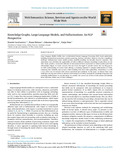Adobe PDF
(1.03 MB)
Knowledge Graphs, Large Language Models, and Hallucinations: An NLP Perspective
Page view(s)
110
checked on Jun 17, 2025
Download(s)
52
checked on Jun 17, 2025


 CC BY-NC-ND 4.0
CC BY-NC-ND 4.0
